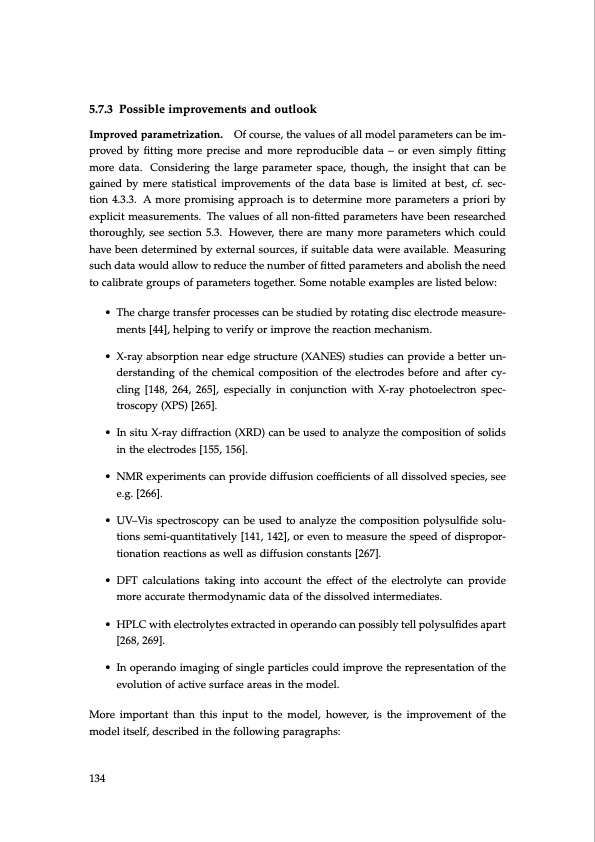
PDF Publication Title:
Text from PDF Page: 134
5.7.3 Possible improvements and outlook Improved parametrization. Of course, the values of all model parameters can be im- proved by fitting more precise and more reproducible data – or even simply fitting more data. Considering the large parameter space, though, the insight that can be gained by mere statistical improvements of the data base is limited at best, cf. sec- tion 4.3.3. A more promising approach is to determine more parameters a priori by explicit measurements. The values of all non-fitted parameters have been researched thoroughly, see section 5.3. However, there are many more parameters which could have been determined by external sources, if suitable data were available. Measuring such data would allow to reduce the number of fitted parameters and abolish the need to calibrate groups of parameters together. Some notable examples are listed below: • The charge transfer processes can be studied by rotating disc electrode measure- ments [44], helping to verify or improve the reaction mechanism. • X-ray absorption near edge structure (XANES) studies can provide a better un- derstanding of the chemical composition of the electrodes before and after cy- cling [148, 264, 265], especially in conjunction with X-ray photoelectron spec- troscopy (XPS) [265]. • In situ X-ray diffraction (XRD) can be used to analyze the composition of solids in the electrodes [155, 156]. • NMR experiments can provide diffusion coefficients of all dissolved species, see e.g. [266]. • UV–Vis spectroscopy can be used to analyze the composition polysulfide solu- tions semi-quantitatively [141, 142], or even to measure the speed of dispropor- tionation reactions as well as diffusion constants [267]. • DFT calculations taking into account the effect of the electrolyte can provide more accurate thermodynamic data of the dissolved intermediates. • HPLC with electrolytes extracted in operando can possibly tell polysulfides apart [268, 269]. • In operando imaging of single particles could improve the representation of the evolution of active surface areas in the model. More important than this input to the model, however, is the improvement of the model itself, described in the following paragraphs: 134PDF Image | Lithium-Sulfur Battery: Design, Characterization, and Physically-based Modeling

PDF Search Title:
Lithium-Sulfur Battery: Design, Characterization, and Physically-based ModelingOriginal File Name Searched:
Dissertation_David_N._Fronczek_The_Lithium_Sulfur_Battery.pdfDIY PDF Search: Google It | Yahoo | Bing
Sulfur Deposition on Carbon Nanofibers using Supercritical CO2 Sulfur Deposition on Carbon Nanofibers using Supercritical CO2. Gamma sulfur also known as mother of pearl sulfur and nacreous sulfur... More Info
CO2 Organic Rankine Cycle Experimenter Platform The supercritical CO2 phase change system is both a heat pump and organic rankine cycle which can be used for those purposes and as a supercritical extractor for advanced subcritical and supercritical extraction technology. Uses include producing nanoparticles, precious metal CO2 extraction, lithium battery recycling, and other applications... More Info
| CONTACT TEL: 608-238-6001 Email: greg@infinityturbine.com | RSS | AMP |